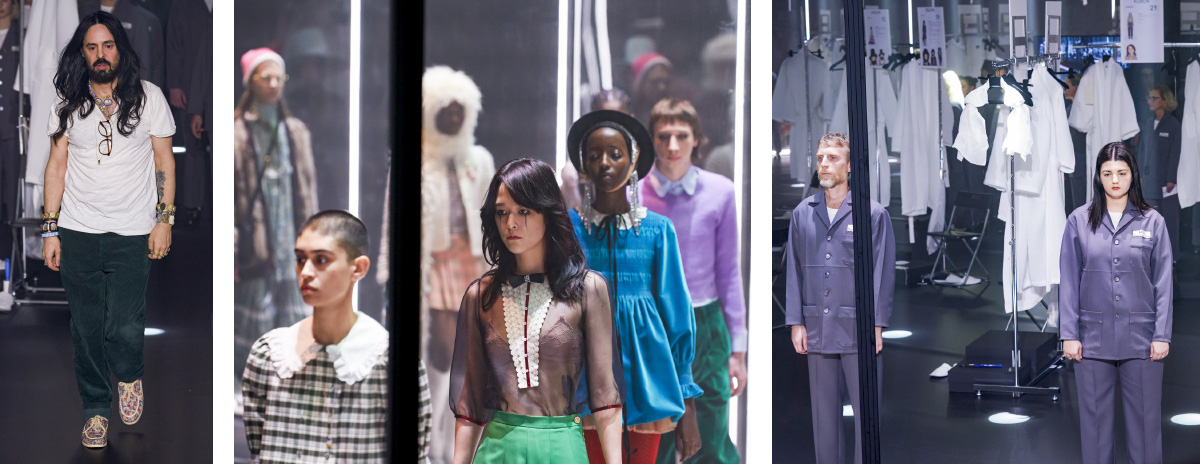The concept of sensuality is increasingly linked with what a person is capable of creating, and no longer to just a look. With Alessandro Michele, Gucci senses this need to express individuality not simply through pure aesthetics, but through a code of communication that mirrors the intellectual and cultural sector within which it operates, delineating an intellectual elite, capable finally of dictating style.
The culture of fashion as value. Intelligence as a tool. Intellectualism as an icon.
After a grave period of disavowal during this isolation, these concepts are regaining global value. Let’s start with the easy definition of culture. More often than not what first springs to mind is an image of an old library, or the silent corridors of a gallery. Places where everything has a cost far greater than its practical value, left to a Wildean reminiscence. Yet every day in this weird period of limbo, it seems that rediscovering the values of the days of yore has become something of a trend, like the floral shirts of the ‘seventies, pantsuits of the ‘eighties and biker jackets of the ‘nineties. Risky comparisons, to be sure.
But all with an element in common: every decade has its distinctive inclination that expresses, represents and exorcises the fears of society, in any given epoch.
That’s the way it’s always been, and the very history of custom teaches it. The interesting aspect of this period, this intense moment in human terms, is that the few have finally understood the importance of a knowledge of culture, intended as the capacity to learn. Mental openness to the variety of possible experiences, against the useless, sterile notionality typical of those who look but can’t see, listen but can’t hear. Suddenly the blank sheet and the pen, cycling or jogging in nature, a book read in the silence of a room, have replaced the toned body fresh from the gym, the bodacious breast enhanced by a clingy dress.

The concept of sexiness, attraction, has always been linked with what a person is capable of doing, creating, and can no longer be mere appearance. Here we have Alessandro Michele, creative director of Gucci, who’s now conquering an increasingly wide audience, not only in numerical terms, but also in terms of social standing and age. Perhaps creatives, too, are feeling that need to express their individuality no simply through purely aesthetic instruments, but using a code of communication that follows the intellectual and cultural sector within which they operate. It seems, in this case, Alessandro Michele wants to give fashion education and culture the importance it deserves. And he’s not afraid to declare this intent, both openly in interviews and implicitly in his collections and how they’re presented. A creative who’s survived a highly unsettling economic crisis, profiling the need for depth in the creation of fashion through an over-exposure of artisan culture in the sartorial cut. And with a brand philosophy no longer seasonal but with a depth in time, the time of people: from youth to old age. A new, ironic and fresh way of expressing a style embracing both the imaginary and the concrete discovery of the everyday. We witnessed the first act of this woke approach in February this year, when Gucci celebrated the magical ritual of the fashion show: a sacred, irreplaceable liturgy transubstantiating creative thought into product offered up to a community of emancipated spectators. Of this ritual we’d like to show what he loves to hide. Indeed, he threw over the tables and brought the models to centre stage: that collective intelligence, inspired and sensitive, that makes the enchantment of beauty possible.

The second act took shape during the May advertising campaign, in yet another effort to overturn the routine mechanisms of fashion. A radical experiment in which Alessandro Michele let himself go to the idea that beauty could manifest, in an unpredictable and marvellously imperfect way, in the absence of control. He abdicated his role as the obsessive director, loosened his grip and abandoned the construction of the scene and the action, letting the models themselves create their own image, playing photographers, story-tellers, producers and set designers.
Then came the epilogue, sealing the closure of this trilogy of love. This final movement gyrated around yet another short-circuit: the clothes were worn by the designers. The designers, who share the everyday burden of creation, became the actors of a new story retaking possession of the poetry they contributed to forging. Staging what each one of us dreams or imagines. An operation that, once again, saw the roles turned. Distance eliminated. The creative act itself expository practise. The interior projected outward. The intangible taking solid form, exploding outward as if by self-combustion. And more, all with the aim of pushing this analysis of the mechanisms governing the world of fashion to the very limit. An unusual way of communicating without falling into the obsessive eccentric, thus dedicated to the aware consumer, attentive and with a desire to appreciate the particularity, though subtle, of an original, cultured product. Vintage references and symbolisms alternating between Dada and the Renaissance draw the traits of an intellectual elite, which founding its premises on a flourishing cultural capacity, finally dictates style.

